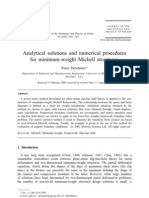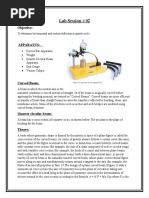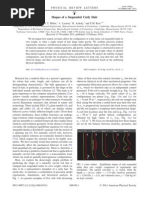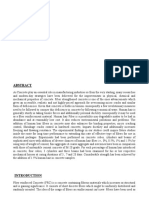Course 09 Curved Bars
Course 09 Curved Bars
Uploaded by
Andrei RacuCopyright:
Available Formats
Course 09 Curved Bars
Course 09 Curved Bars
Uploaded by
Andrei RacuCopyright
Available Formats
Share this document
Did you find this document useful?
Is this content inappropriate?
Copyright:
Available Formats
Course 09 Curved Bars
Course 09 Curved Bars
Uploaded by
Andrei RacuCopyright:
Available Formats
TRANSILVANIA UNIVERSITY OF BRASOV
MECHANICAL ENGINEERING FACULTY
DEPARTMENT OF MECHANICAL ENGINEERING
ONLY FOR STUDENTS
Course 9
Curved bars
9.1. Introduction
The beams with plane or spatial curved longitudinal axes are called curved bars. There are
considered two classes of problems:
a) initially curved beams where the depth of cross-section can be considered small in
relation to the initial radius of curvature.
b) those beams where the depth of cross-section and initial radius of curvature are
approximately of the same order, i.e. deep beams with high curvature.
c) The high curved bars bending theory was developed by Emile Winkler.
9.2. Initially curved slender beams
In this case the ration of
R
5 ... 6 , where R is the curvature ob the bar and h is the height
h
of the cross section.
Let considered the curved bar from Figure 9.1. Under the complex load consisting of forces
and
moments
generic
denoted
with
Pi (i 1, 2,..., n,..., q,...) , in the cross sections are
P
developed tensile and shear forces N, and T
and bending moments M b .
M
G
As is known the tensile force N generate
a
normal
stress uniformly distributed on the
N
T
cross section surface:
n
Pk
Pq
O
(9.1)
where A is the value of the cross section area.
The shear force T develop a shear stress
that is calculated with Juravski relationship:
Figure 7.1
N
,
A
T Sz
.
b Iz
STRENGTH OF MATERIALS - PART II
(9.2)
Prof.dr.ing. Ioan Calin ROSCA
TRANSILVANIA UNIVERSITY OF BRASOV
MECHANICAL ENGINEERING FACULTY
DEPARTMENT OF MECHANICAL ENGINEERING
ONLY FOR STUDENTS
The normal stress generated by the bending moment is found out with the classical Naviers
relationship:
Mb
y.
Iz
(9.3)
9.3. Deep beams with high initial curvature
R
5... 6 , where R is the curvature ob the bar and h is the height of
h
the cross section, the bars are considered to have high initial curvature (i.e. small radius of
curvature). In this case the bending stress has to be calculate with the theory developed by Emile
Winkler.
The theory is based on the
following assumptions:
The longitudinal axes are situated in a
single plane;
This plane is, in the same time, a
symmetry plane of the bar;
All the loads are applied in the same
plane that is the symmetry plane;
The cross section is considered to be
constant along the bar;
The material satisfy the Hookes law;
It
is respected the Bernoullis
assumption which states that the
plane cross sections are normal to the
longitudinal axes before and after
deformation (the shape of the cross
section is changed, under loads, in a
neglected ratio and so one can
consider that remains the same);
It is neglected the compression
developed on radial direction by the
bending moment between the fibres.
It is considered a part of a plane
curved bar defined by angle d
(Figure 9.2).
There are made the following
Figure 9.2
notations:
R1 - inner fibre radius; R2 - external fibre radius; R - distance from the curvature centre C to the
centre of gravity G ; r - is the distance to the neutral axis O O ; - is the curvature radius of a
fibre.
In case of a ration of
STRENGTH OF MATERIALS - PART II
Prof.dr.ing. Ioan Calin ROSCA
TRANSILVANIA UNIVERSITY OF BRASOV
MECHANICAL ENGINEERING FACULTY
DEPARTMENT OF MECHANICAL ENGINEERING
ONLY FOR STUDENTS
Under the action of the bending moment M b the end sections (end edges) of the considered
element rotate one to the other one with an angle equal with d . To simplify the calculation one
can consider that only one end edge is rotated around the neutral axe.
There are made the following specifications:
The fiber that is situated on the neutral axe dose not changes its length. The
neutral axe divides the cross section in two parts: one where the normal stress
is positive (tensile), and the other one where the value of stress is negative one
(compression);
In the case of curved bars the neutral axe is not the same with the axe of the cross
sections centers of gravity (longitudinal axe) and results that it is necessary to
find out the position of neutral axe.
It is considered a fiber that has the length equal with ds that is situated at a distance y from
the neutral axe. The length of the fiber can be calculate, based on Figure 9.2, as:
ds d .
(9.4)
Under the bending load, the fiber length growth with a quantity ds that, according with
Bernoullis assumption, is:
ds y d .
(9.5)
As it can be seen in Figure (9.2), between the two quantities and y exists the
relationship:
y r.
(9.6)
As was mentioned, it is considered that the material satisfies the Hookes law. This
assumption leads to the possibility to write, based on relationships (9.4) (9.6) the strain material
as:
ds
y d
r d
,
ds
d
(9.7)
and the normal stress as:
E E
r ds
d y
.
d
d r y
(9.8)
Observations:
From relationship (9.8) results that the variation of the normal stress , on the cross
sections, is represented by a hyperbolic function;
The highest values are developed in the fibres that are situated at the extreme edges of
the cross section;
In the neutral axe r or y 0 the normal stress is zero 0 .
3
STRENGTH OF MATERIALS - PART II
Prof.dr.ing. Ioan Calin ROSCA
TRANSILVANIA UNIVERSITY OF BRASOV
MECHANICAL ENGINEERING FACULTY
DEPARTMENT OF MECHANICAL ENGINEERING
ONLY FOR STUDENTS
As it is known there are two relationships of equivalency written as:
that, based on (9.8) become:
dA 0 ;
A
y dA M b ,
A
(9.9)
dx r
E dx dA 0 ;
A
2
E dx r dA M .
b
dx A
(9.10)
From the first equation of (9.10) one can obtain the geometric position of neutral axe:
that leads to:
dA r
dA
A 0 ,
A
,
dA
(9.11)
(9.12)
and the integral from denominator has different values according with the cross section shape.
From the second relationship of (9.10) is obtained the relationship of strain:
d
Mb
r 2
(9.13)
dA
The value of integral from relationship (9.13) is:
r 2 dA r 2
dA
2r dA dA rA 2rA RA Ae . (9.14)
A
Introducing (9.14) in (9.13) one can obtain:
d M b
,
d EA e
(9.15)
that combined with (9.8) leads to the normal stress formula:
Mb r
1 ,
Ae
STRENGTH OF MATERIALS - PART II
Prof.dr.ing. Ioan Calin ROSCA
TRANSILVANIA UNIVERSITY OF BRASOV
MECHANICAL ENGINEERING FACULTY
DEPARTMENT OF MECHANICAL ENGINEERING
ONLY FOR STUDENTS
or,
Mb y
.
Ae r y
(9.16)
Considering the geometrical notations there are obtained the following relationships for the
stresses developed in extremely edges:
M b y1
;
A e R1
M y
2 b 2 .
A e R2
inner edge:
outer edge:
(9.17)
(9.18)
In the case of a tensile load that is superposed on the bending load, the total stress is given
by:
N Mb y
.
A Ae r y
STRENGTH OF MATERIALS - PART II
(9.19)
Prof.dr.ing. Ioan Calin ROSCA
You might also like
- On Bending Stiffness of Composite TubesDocument7 pagesOn Bending Stiffness of Composite TubesJeremy WilliamsNo ratings yet
- Mechanical Engineering PresentationDocument7 pagesMechanical Engineering Presentationandre100% (1)
- Critical Buckling EquationDocument18 pagesCritical Buckling Equationxsi666No ratings yet
- Euler Buckling Lab 2Document18 pagesEuler Buckling Lab 2Sameer shaikh100% (1)
- AASHTO T315-12 Standard Method of Test For Determining The Rheological Properties of Asphalt Binder Using A Dynamic Shear Rheometer (DSR) - LightDocument33 pagesAASHTO T315-12 Standard Method of Test For Determining The Rheological Properties of Asphalt Binder Using A Dynamic Shear Rheometer (DSR) - LightDanny100% (1)
- DESMODUR MDQ23165+BAYTEC D22-70MF+BAYTEC XL B (SD6-2) Ang Ind0Document2 pagesDESMODUR MDQ23165+BAYTEC D22-70MF+BAYTEC XL B (SD6-2) Ang Ind0Jorge Miguel Bravo Cardenas100% (1)
- ASTM D1238 ExplainedDocument3 pagesASTM D1238 ExplainedAlex Kiko Villalobos100% (1)
- Large Deflections of Cantilever BeamsDocument4 pagesLarge Deflections of Cantilever BeamsHasan Ayouby100% (1)
- XCIV The Large Deflection of Simply Supported BeamsDocument8 pagesXCIV The Large Deflection of Simply Supported BeamsFacheng ZhaoNo ratings yet
- Timoshenko CoefficientDocument6 pagesTimoshenko CoefficientwarterflyNo ratings yet
- 1.1. STRESS: Figure ADocument27 pages1.1. STRESS: Figure AJayNo ratings yet
- LectureDocument8 pagesLectureRohit PareekNo ratings yet
- Deformation Analysis For The Rotary Draw Bending Process of Circular Tubes - Stress Distribution and Wall ThinningDocument5 pagesDeformation Analysis For The Rotary Draw Bending Process of Circular Tubes - Stress Distribution and Wall ThinningkiranNo ratings yet
- Som Unit - IIIDocument32 pagesSom Unit - IIIiliyasiliyas6721No ratings yet
- Variational Asymptotic BeamDocument43 pagesVariational Asymptotic BeamAdimasu AyeleNo ratings yet
- Yakobson 1996Document4 pagesYakobson 1996gouravNo ratings yet
- Anticlastic Action of Flat Sheets in BendingDocument5 pagesAnticlastic Action of Flat Sheets in Bendingalfakir fikriNo ratings yet
- (Jonsson & Ramonas, 2012) - Flange Curling in Cold Formed ProfilesDocument11 pages(Jonsson & Ramonas, 2012) - Flange Curling in Cold Formed Profileschristos032No ratings yet
- Analysis of Three Dimensional HorizontalDocument6 pagesAnalysis of Three Dimensional Horizontalhussain adelNo ratings yet
- Stresses From Radial Loads and External Moments in Spherical Pressure VesselsDocument11 pagesStresses From Radial Loads and External Moments in Spherical Pressure VesselsbahmanNo ratings yet
- Effect OF: Axial Loads On Radial Stress in Curved BeamsDocument13 pagesEffect OF: Axial Loads On Radial Stress in Curved BeamsRenner EgalonNo ratings yet
- Stresses in Beams: JU. Dr. Ibrahim Abu-AlshaikhDocument20 pagesStresses in Beams: JU. Dr. Ibrahim Abu-AlshaikhqusayNo ratings yet
- Lecture 25 and 26Document8 pagesLecture 25 and 26ardikurniawanNo ratings yet
- Flange Curling in Cold Formed Profiles PDFDocument10 pagesFlange Curling in Cold Formed Profiles PDFDiogoPintoTarrafaNo ratings yet
- Outcome1 T1 PDFDocument12 pagesOutcome1 T1 PDFM RoyNo ratings yet
- The Elements of Draping: E. Cerda, L. Mahadevan, and J. M. PasiniDocument5 pagesThe Elements of Draping: E. Cerda, L. Mahadevan, and J. M. PasiniAmin Hidjab LahceneNo ratings yet
- Institute of Engineering Thapathali Campus: A Lab Report On Deflection of BeamsDocument17 pagesInstitute of Engineering Thapathali Campus: A Lab Report On Deflection of BeamsBarun ShresthaNo ratings yet
- Physics QB 1Document16 pagesPhysics QB 1Vedant GaikwadNo ratings yet
- Outcome 01 t1Document12 pagesOutcome 01 t1alexandre_motta_3No ratings yet
- Strengths 3rd ChapterDocument10 pagesStrengths 3rd Chapteryodahe aberaNo ratings yet
- Coursework BeamDocument29 pagesCoursework BeamandrewsugihartoNo ratings yet
- Euler Bernoulli BeamsDocument8 pagesEuler Bernoulli BeamsDorin PopaNo ratings yet
- S. Neukirch, G.H.M. Van Der Heijden and J.M.T. Thompson - Writhing Instabilities of Twisted Rods: From Infinite To Finite LengthDocument17 pagesS. Neukirch, G.H.M. Van Der Heijden and J.M.T. Thompson - Writhing Instabilities of Twisted Rods: From Infinite To Finite LengthLokosooNo ratings yet
- Simple Bending TheoryDocument11 pagesSimple Bending TheoryAnonymous 2RduvkjgZNo ratings yet
- Stresses in BeamsDocument9 pagesStresses in BeamsAyad SlabyNo ratings yet
- FERDIN 1 (1) - Removed - Removed (1) - RemovedDocument3 pagesFERDIN 1 (1) - Removed - Removed (1) - RemovedGildardo VillalpbosNo ratings yet
- Module 1 StressDocument20 pagesModule 1 StressKylla Shane DuntonNo ratings yet
- Analytical Solutions and Numerical Procedures For Minimum-Weight Michell StructuresDocument23 pagesAnalytical Solutions and Numerical Procedures For Minimum-Weight Michell StructuresWolelaw EndalewNo ratings yet
- Design and Construction of A Structure For A Three Point Bending TestDocument13 pagesDesign and Construction of A Structure For A Three Point Bending TestIñigoNo ratings yet
- Curved Beams C&yDocument17 pagesCurved Beams C&yfsirfan0% (1)
- Lab Session 2 MomDocument7 pagesLab Session 2 Momm.sheraz malikNo ratings yet
- The Bending of Beams and The Second Moment of Area: Chris Bailey, Tim Bull and Aaron LawrenceDocument12 pagesThe Bending of Beams and The Second Moment of Area: Chris Bailey, Tim Bull and Aaron LawrenceNitin shepurNo ratings yet
- S. Choi Et Al - Excitation Spectrum of Vortex Lattices in Rotating Bose-Einstein CondensatesDocument4 pagesS. Choi Et Al - Excitation Spectrum of Vortex Lattices in Rotating Bose-Einstein CondensatesLomewcxNo ratings yet
- Revised 8 - Deflection of Beams - 1Document11 pagesRevised 8 - Deflection of Beams - 1Sehran MuhammadNo ratings yet
- Shapes of A Suspended Curly Hair: Week Ending 14 FEBRUARY 2014Document5 pagesShapes of A Suspended Curly Hair: Week Ending 14 FEBRUARY 2014MaingotNo ratings yet
- Axial Load Frequencies BeamsDocument33 pagesAxial Load Frequencies BeamsKhristiam AlvarezNo ratings yet
- Cylindrically Orthotropic Circular Plates With Large Deflections 1)Document11 pagesCylindrically Orthotropic Circular Plates With Large Deflections 1)yasameenNo ratings yet
- Lateral-Torsional Buckling of Beams and The Southwell PlotDocument15 pagesLateral-Torsional Buckling of Beams and The Southwell PlotPablo Augusto Krahl0% (1)
- Choi 2000 Free Spanning Analysis of Offshore PipelinesDocument14 pagesChoi 2000 Free Spanning Analysis of Offshore Pipelinesbello imamNo ratings yet
- Bending of Thin Circular RingsDocument14 pagesBending of Thin Circular RingsozkanhasanNo ratings yet
- Alain Goriely and Michael Tabor - Nonlinear Dynamics of Filaments III: Instabilities of Helical RodsDocument20 pagesAlain Goriely and Michael Tabor - Nonlinear Dynamics of Filaments III: Instabilities of Helical RodsDopameNo ratings yet
- Macaulay's Method 1011Document108 pagesMacaulay's Method 1011Medha KapoorNo ratings yet
- Theory of Elastisity, Stability and Dynamics of Structures Common ProblemsFrom EverandTheory of Elastisity, Stability and Dynamics of Structures Common ProblemsNo ratings yet
- Design Preboard PracticeDocument13 pagesDesign Preboard PracticeKyle MarfsNo ratings yet
- IonizationDocument23 pagesIonizationbalweg mackyNo ratings yet
- Welding DefectDocument14 pagesWelding DefectAfewerk RedaNo ratings yet
- 1 s2.0 S0020169309003971 MainDocument8 pages1 s2.0 S0020169309003971 MainusmanNo ratings yet
- Gas Dynamics Unit 3 Clear Notes.208-248Document41 pagesGas Dynamics Unit 3 Clear Notes.208-248ChandrakanthPrinceNo ratings yet
- Past 22 Phy Sics CH 14,15,16 Final MCQS-1Document10 pagesPast 22 Phy Sics CH 14,15,16 Final MCQS-1wali rajpootNo ratings yet
- Self Generating SensorsDocument23 pagesSelf Generating SensorsVhan DarshNo ratings yet
- XRD ICDD - Mar 07 B - HeDocument23 pagesXRD ICDD - Mar 07 B - HePrabhakran Perumal100% (1)
- Refraction IgnitedDocument6 pagesRefraction IgnitedAbhijeet KumarNo ratings yet
- Oh-Lite®: Single Mode Optical Fibre ITU-T G.652.DDocument2 pagesOh-Lite®: Single Mode Optical Fibre ITU-T G.652.Dhimanshi khivsaraNo ratings yet
- LASER C (E) - 27aDocument12 pagesLASER C (E) - 27apc100xohmNo ratings yet
- Review of Parameters Influencing Wireless Energy Transmission by Magnetic InductionDocument19 pagesReview of Parameters Influencing Wireless Energy Transmission by Magnetic InductionIJAR JOURNALNo ratings yet
- SinteringDocument2 pagesSinteringEfvan Adhe Putra PradanaNo ratings yet
- FORGINGDocument14 pagesFORGINGKhan MARCEL NjiNo ratings yet
- Book 4 (ATP Topical)Document262 pagesBook 4 (ATP Topical)ABDULLAH'S SWEET VIDEOSNo ratings yet
- Problem Set IDocument2 pagesProblem Set Iright12351No ratings yet
- MaterialData - 56973 2Document2 pagesMaterialData - 56973 2red_beastNo ratings yet
- Addition Polymerisation of Dental MaterialDocument17 pagesAddition Polymerisation of Dental MaterialHaffie HafiziNo ratings yet
- Nanotechnologies - Assessment of Nanomaterial Toxicity Using Dechorionated Zebrafish EmbryoDocument3 pagesNanotechnologies - Assessment of Nanomaterial Toxicity Using Dechorionated Zebrafish EmbryoCappucino NingningNo ratings yet
- HDBK 17 1FDocument586 pagesHDBK 17 1FmihailmiNo ratings yet
- Physics 1Document9 pagesPhysics 1Paneer ManteNo ratings yet
- som imp qsDocument10 pagessom imp qsMohammed Mustafa Rayhan KhadariNo ratings yet
- Linear Response TheoryDocument13 pagesLinear Response Theorynaveedulhaq07No ratings yet
- 2000 Words PDFDocument5 pages2000 Words PDFshoaibNo ratings yet
- Crumb Rubber ModifierDocument13 pagesCrumb Rubber ModifierPerkresht PawarNo ratings yet
- Unit-Iii FLUID DYNAMICS: Surface and Body Forces, Concepts of Fluid System andDocument23 pagesUnit-Iii FLUID DYNAMICS: Surface and Body Forces, Concepts of Fluid System andyrajesh1050% (2)

























































































